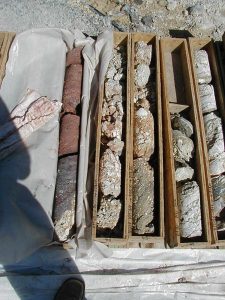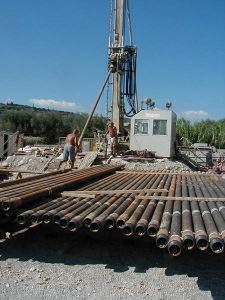Some characteristics of drilling techniques
PDF
These exploration wells can have various depths. The deepest ever reached a depth of 12,345 m, near the island of Sakhalin in eastern Russia. In addition to collecting rock samples, drill holes allow a number of geophysical measurements to be carried out in situ. The description of continuous variations of a physical property along a well is called a log. For example, sonic logging is used to describe variations along the borehole in the propagation velocity of so-called sound waves, i.e. waves emitted in a frequency range covering the sensitivity range of our hearing (20 Hz-10 000 Hz).

The rock debris (cuttings) is brought to the surface by a circulation of mud injected by the drill string. The viscosity of this slurry is adjusted for optimum cutting removal and its density is adjusted to ensure the stability of the borehole during drilling.

When the borehole reaches a certain depth, it must be tubed regularly to balance the stresses supported by the rock at the borehole wall. This operation is called the casing of the well , and the steel pipe left in place is called the casing. During its manufacture, the casing may have a certain number of slots to allow the production of the required fluid. But more often than not, the casing is cemented to prevent any fluid from rising along the borehole outside the casing. The production of fluid is then ensured, once the casing has been placed in a watertight manner, thanks to perforations made using various techniques that vary according to the operators.
With the traditional drilling technique, the drill string allows on the one hand to inject the mud used to extract rock debris, and on the other hand to rotate the drilling tool on its axis. This rotation operation involves significant friction throughout the drilling process and therefore causes rapid wear of the drill string for deep drilling. To overcome these difficulties, drill heads that can rotate on themselves thanks to the injected mud pressure, without rotating the drill string, have gradually been developed. These turbines have also provided the opportunity to better control the drilling direction. These techniques now allow horizontal drilling operations over distances of up to ten kilometres.




